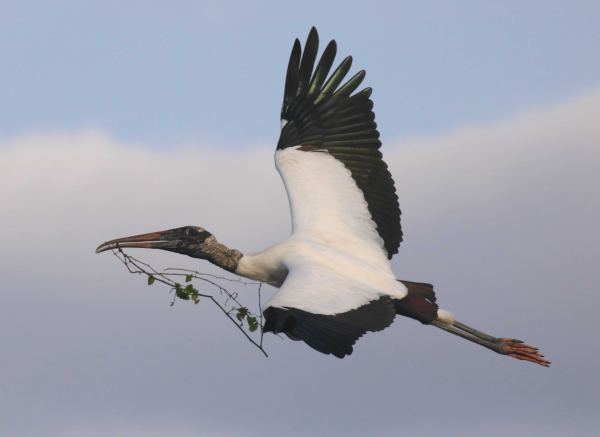
Wood Storks, the only stork species to nest in the United States, begin nesting during winter, depending on water levels in Florida’s wetlands (photo by Paul Konrad).
|
Florida’s wading bird nesting season is about to begin! From December to July, Wood Storks – along with Roseate Spoonbills, egrets, ibis, and herons assemble in southern Florida to nest and raise their young of the year. Because the nesting success of Wood Storks and other wading birds depends so much on when, where, and how water moves through South Florida, these birds are a great indicator of how far we’ve come toward restoring America’s Everglades wetland quality.
Historically, the Everglades is a mecca for anyone looking to see Wood Storks and a host of wading birds. However, a century spent draining and channeling Florida’s wetlands have dramatically reduced habitat and caused bird populations to suffer. The “River of Grass” once covered more than three million acres as it slowly flowed from headwaters in the Kissimmee River near the center of the state, all the way south through what is now Everglades National Park and into Florida Bay. Currently, less than half of this wetland ecosystem remains. Lake Okeechobee – the liquid heart of the Everglades – is now cut off from the southern Everglades and Florida Bay.
A Rejuvenated Nesting Season
During 2018, perfect water conditions sparked the best nesting season in more than 80 years for many wading birds, giving us a glimpse of what restoring America’s Everglades could mean for the future of wading birds. Heavy rains in 2017 flooded wetlands, resulting in exploding populations of fish and other prey. Subsequent dry weather caused water to slowly recede, creating ideal conditions for wading birds to feed on prey crowded into pockets of water.
During 2018, wading birds flocked to nesting sites they previously abandoned in the southern Everglades, indicating that more freshwater reached coastal estuaries in Everglades National Park. Tree islands in the central Everglades were surrounded by enough water to keep predators like raccoons away from colonies of nesting birds. Pairs of Wood Storks built nearly 6,000 nests, which was more than twice the 10-year average and the third-highest count since the late 1960s!
Last year’s nesting bonanza is proof that the Everglades is resilient enough to support large numbers of wading birds – a strong sign that if there’s enough clean water where it has historically been available, at the right time of year, wading birds will return and thrive. There are several key projects that, when completed, will help restore a more natural flow of water south from Lake Okeechobee to Everglades National Park and Florida Bay.
This year, we have a major opportunity to secure historic funding to restore America’s Everglades and safeguard habitat for threatened Wood Storks and other wading birds. The House of Representatives recently passed a bill that would invest $200 million for Everglades restoration. Now it’s up to the U.S. Senate to pass a bill that makes the same historic investment in the Everglades. You can help by contacting your senators to share your interest in this bill. That’s a part of being a birder too, and your participation will help to ensure the future of wading birds including the threatened American population of Wood Storks so you and millions of people can appreciate the birds and other wildlife that depends on the Everglades and other important wetland areas.
You can refer to the original National Wildlife Federation article at https://blog.nwf.org/2019/11/water-for-wood-storks/